Contents
Market Overview
Macro Review
Inflation records are meant to be broken. Eurozone inflation rose to 8.6% from 8.1% in May, just as Spanish and French inflation hit multi-year highs 10.2% and 5.8%, respectively. Global interest rates rallied over the past week by 10-25bp across Europe and the U.S., while commodities sold-off in an aggressive fashion and recessionary risks became more prevalent. Even major cryptocurrencies were down 8-15%, with Bitcoin below $19,000 momentarily. Themes over the week include: (1) China’s rebound with a jump in non-manufacturing PMIs to 54.7 for June from 47.8 previously; (2) Colombia’s largest rate hike in over 20 years (150bp) to 7.5% as inflation hit 9.1%; (3) South Africa’s SARB was seen as credible with Governor Kganyago guiding a 50bp hike in July, but load shedding is weighing on FX along with the broader commodity sell-off; (4) Hungary aggressively hiked rates by 185bp relative to consensus of 50bp, although the NBH sought to simplify the interest rate policy framework; and (5) the ECB’s Sintra forum offered a more hawkish impression of what to expect over the summer period and the pace of tightening both in July and September. As these events unraveled, the Fed’s Atlanta nowcast GDP moved to -1.0% for 2Q having previously been at 0.3%, which added to the stagflation-cum-recession theme. This was fueled further by the weak U.S. ISM readings.
EM Credit Update
Emerging market sovereign credit ended the week down 1.5% with spreads 36bp wider. However, the relative strength in EM corporate credit was telling and only down 0.4% with spreads widening 19bp. Outperformers over the week were Croatia, Malaysia and China while Sri Lanka, Ukraine and Zambia underperformed. The move in U.S. Treasuries had also become notable, as the 2-year note broke through its support level and the June 2023 eurodollar contract (EDM3) traded above its downtrend line. These technical features contributed to a rally as the peak inflation narrative gathered further momentum after the recent PCE release (despite trends in Europe).
The Week Ahead
Next week the G20 foreign ministers will meet in Bali as further support measures for Ukraine will be discussed. Financial markets will also watch the US non-farm payrolls release closely, along with ECB minutes and the Reserve Bank of Australia’s interest rate decision. After the recent strength in Chinese NBS PMIs (and notably the service sector), the focus shifts to CPI and PPI inflation. The Caixin Manufacturing PMI also complemented the NBS release, highlighting the highest release since May 2021 at 51.7 up from 48.1 previously. Interest rate decisions are then due from Israel (0.75%), Malaysia (2.0%), Poland (6.0%) and Romania (3.75%). Inflation is due out of Brazil, Chile, Colombia, Mexico, Philippines, South Korea, Taiwan, Thailand and Turkey. Aside from Turkish inflation, the current account release is also a key fixture for next week.
Highlights from emerging markets discussed below include: Jose Antonio Ocampo, an orthodox economist with strong market credentials, appointed Colombia’s Finance Minister; China June PMIs move back into expansionary territory; and Argentina receives IMF board approval on 1st program review; FX pressures abate amid new controls.
Fixed Income
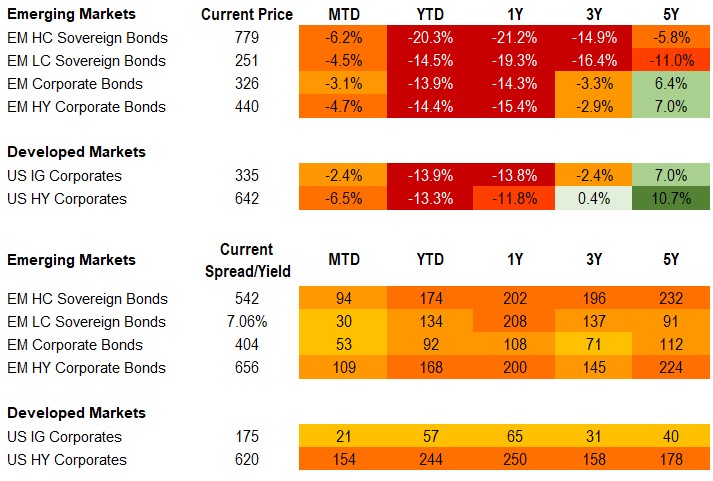
Equities
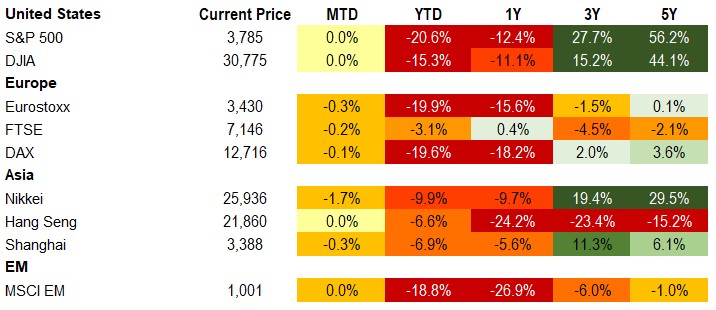
Commodities

Source for data tables: Bloomberg, JPMorgan, Gramercy. EM Fixed Income is represented by the following JPMorgan Indicies: EMBI Global, GBI-EM Global Diversified, CEMBI Broad Diversified and CEMBI Broad High Yield. DM Fixed Income is represented by the JPMorgan JULI Total Return Index and Domestic High Yield Index. Fixed Income, Equity and Commodity data is as of July 1, 2022 (mid-afternoon).
Emerging Markets Weekly Highlights
Jose Antonio Ocampo, an orthodox economist with strong market credentials, appointed Colombia’s Finance Minister
Event: Colombia’s President-Elect Gustavo Petro named Jose Antonio Ocampo, one of the country’s most highly respected economists, as his finance minister.
Gramercy commentary: Jose Antonio Ocampo was most recently an economics professor at Columbia University in New York and Co-Director of the Central Bank and has already served as Colombia’s Finance Minister in the late 1990s. His reputation of a brilliant orthodox economist will likely reassure markets that have been concerned about the trajectory of Colombia’s economic policy under Petro, who will become the country’s first left-wing president in its modern history, when he assumes office on August 7. Besides his strong market credentials, Mr. Ocampo was also a vocal critic of Mr. Petro’s fiscal spending plans during the pre-election period, which might signal that the President-Elect would prefer a more conservative government spending approach once in office. In addition to the credit-positive appointment of Mr. Ocampo, Mr. Petro has also reached out to and met with his main political opponent from the right-wing of Colombia’s political spectrum, former president, Alvaro Uribe. We construe this as another constructive sign that “building bridges” around key policy/political issues seems to be one of Petro’s priorities, at least in the early days of his Administration. Putting all of this together, we see a window of opportunity in which markets should give the new Petro Administration the “benefit of the doubt” in terms of economic policy, potentially setting the stage for a general recovery in Colombian assets that have been trading at historic high-risk premiums versus peers.
China June PMIs move back into expansionary territory
Event: NBS composite PMI jumped 6pts to 54.1 with the non-manufacturing index leading the gains at 54.7 and manufacturing at 50.2 The price input and delivery components continued to show multi-point improvements reflecting easing of supply constraints in context of reduced COVID restrictions.
Gramercy commentary: The data suggests that the gradual recovery remains intact as virus related measures have been eased (roughly 9% of GDP vs. peak of ~35% of GDP) and incremental policy support trickles-in. We see this combined with slight loosening on COVID quarantine guidelines as supportive for the coming months, barring widespread deterioration of virus conditions. Still, the smaller increase in manufacturing output of just 0.6pts speaks to the limitations on the credit push from a demand perspective and a more targeted nature. Meanwhile, speculation on prospects for U.S. tariff relief continues in the background. While not our base case, select removal on non-strategic products and reduction on consumer goods could add an estimated 0.25-0.4% pts to annual growth.
Argentina receives IMF board approval on 1st program review; FX pressures abate amid new controls
Event: Following a staff-level agreement earlier this month, the IMF Board approved the first review as expected and disbursed $4bn, which following repayments to the fund in June (already made) and July will result in a net decline in FX reserves of ~$450mm. Domestic financing conditions were under strain heading into the large maturities at month-end but with BCRA support in the secondary market, conditions were able to roll successfully. With pressured net FX reserves in a strained external and domestic backdrop, the authorities tightened FX controls on imports and extended the measures through September. The gap between the parallel and official rates hovered around 100% for most of the week up significantly from an average of 80% in May but down from the peak of 120% touched mid-month.
Gramercy commentary: We see the IMF review as constructive but with lingering uncertainties that will likely continue to drive asset price volatility. Despite interim revisions, program targets remain difficult to achieve in the context of a domestic market that will likely remain under pressure with maturities picking up again in late July and peaking in September and little FX reserve support aside from BOP control tactics. Our base case remains for patience and flexibility from the Fund with potential for tweaks on the fiscal side and greater leniency allotted on Central Bank financing to avoid arrears. With that being said, macroeconomic and political dynamics are increasingly fragile leaving uncertainty high. All else equal, the current backdrop continues to favor political change over the medium term with polls showing growing opposition support.
Emerging Markets Technicals
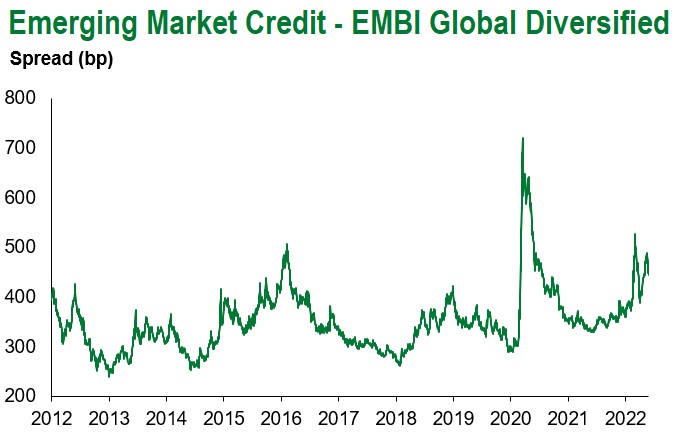
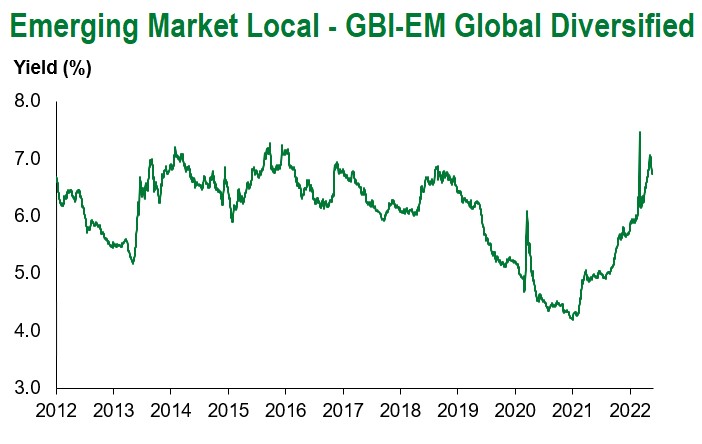
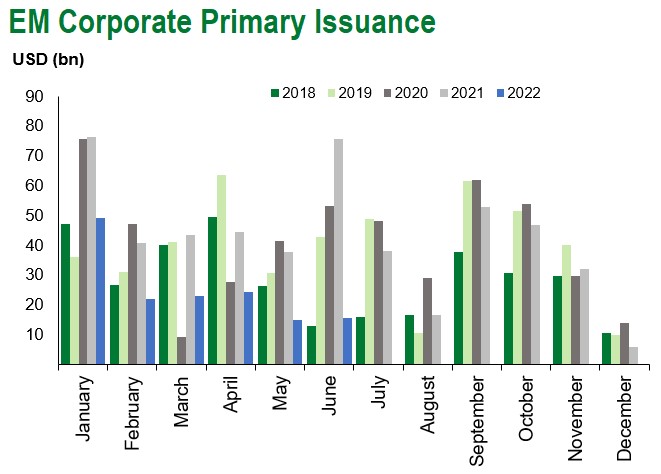
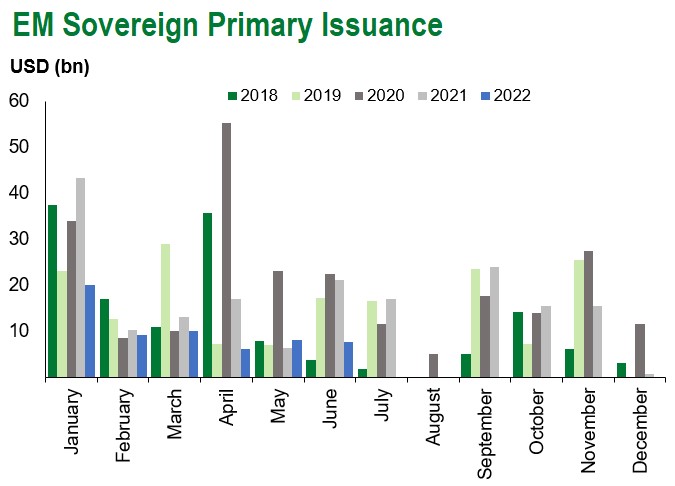
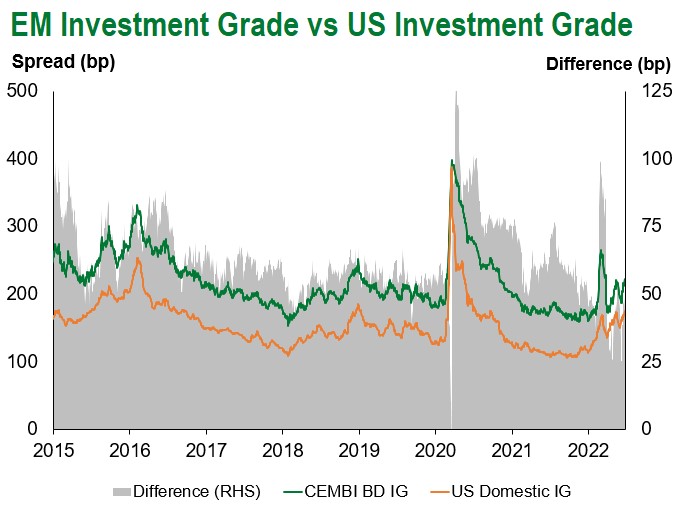
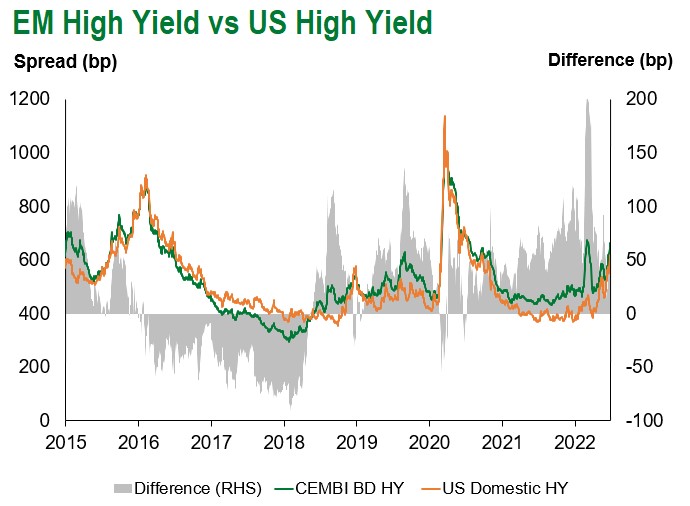
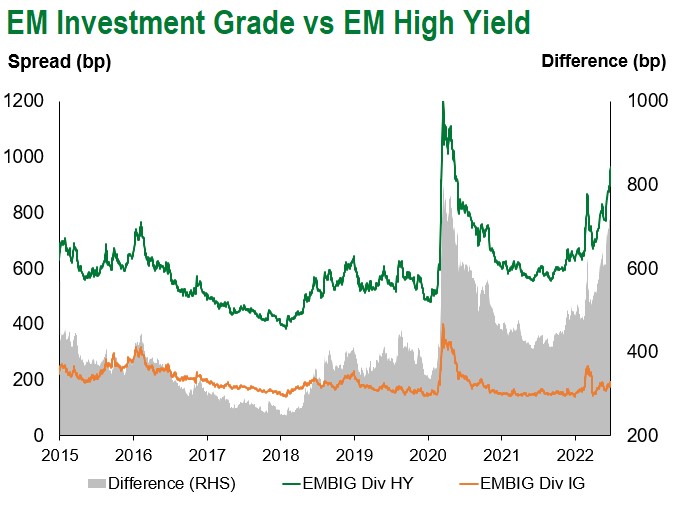
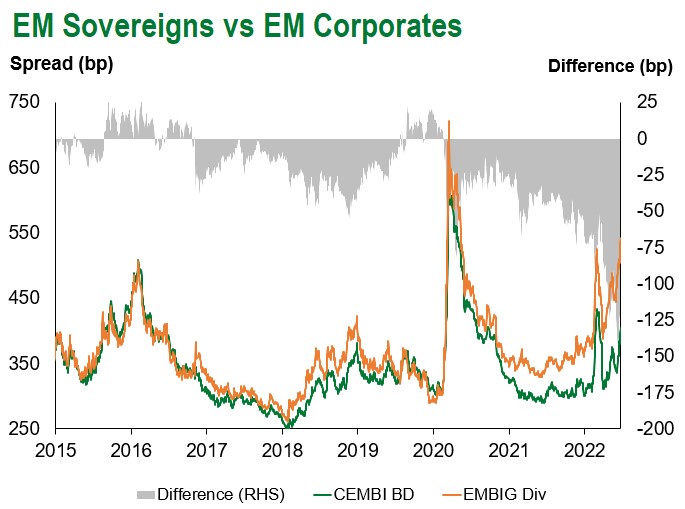
Emerging Markets Flows
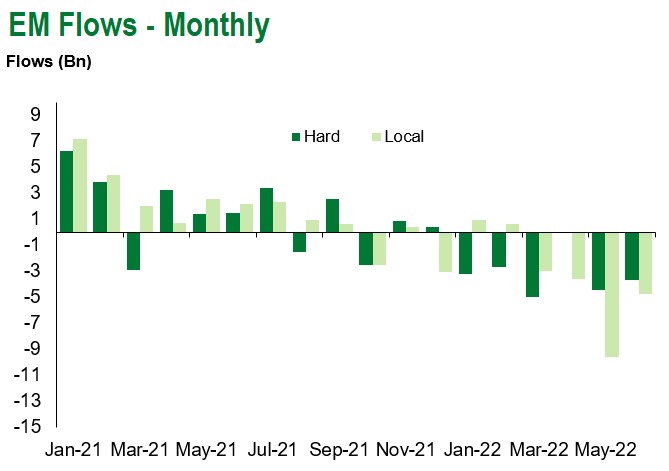
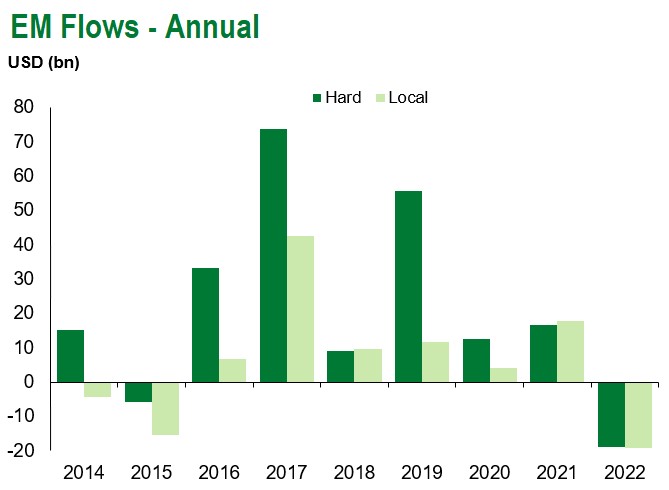
Source for graphs: Bloomberg, JPMorgan, Gramercy. As of July 1, 2022.
COVID Resources:
Johns Hopkins COVID-19 Case Tracker
For questions, please contact:
Kathryn Exum, CFA ESG, Director, Co-Head of Sovereign Research, [email protected]
Petar Atanasov, Director, Co-Head of Sovereign Research, [email protected]
James Barry, Director, Deputy Portfolio Manager, [email protected]
This document is for informational purposes only. The information presented is not intended to be relied upon as a forecast, research or investment advice, and is not a recommendation, offer or solicitation to buy or sell any securities or to adopt any investment strategy. Gramercy may have current investment positions in the securities or sovereigns mentioned above. The information and opinions contained in this paper are as of the date of initial publication, derived from proprietary and nonproprietary sources deemed by Gramercy to be reliable, are not necessarily all-inclusive and are not guaranteed as to accuracy. This paper may contain “forward-looking” information that is not purely historical in nature. Such information may include, among other things, projections and forecasts. There is no guarantee that any forecasts made will come to pass. Reliance upon information in this paper is at the sole discretion of the reader. You should not rely on this presentation as the basis upon which to make an investment decision. Investment involves risk. There can be no assurance that investment objectives will be achieved. Investors must be prepared to bear the risk of a total loss of their investment. These risks are often heightened for investments in emerging/developing markets or smaller capital markets. International investing involves risks, including risks related to foreign currency, limited liquidity, less government regulation, and the possibility of substantial volatility due to adverse political, economic or other developments. The information provided herein is neither tax nor legal advice. Investors should speak to their tax professional for specific information regarding their tax situation.